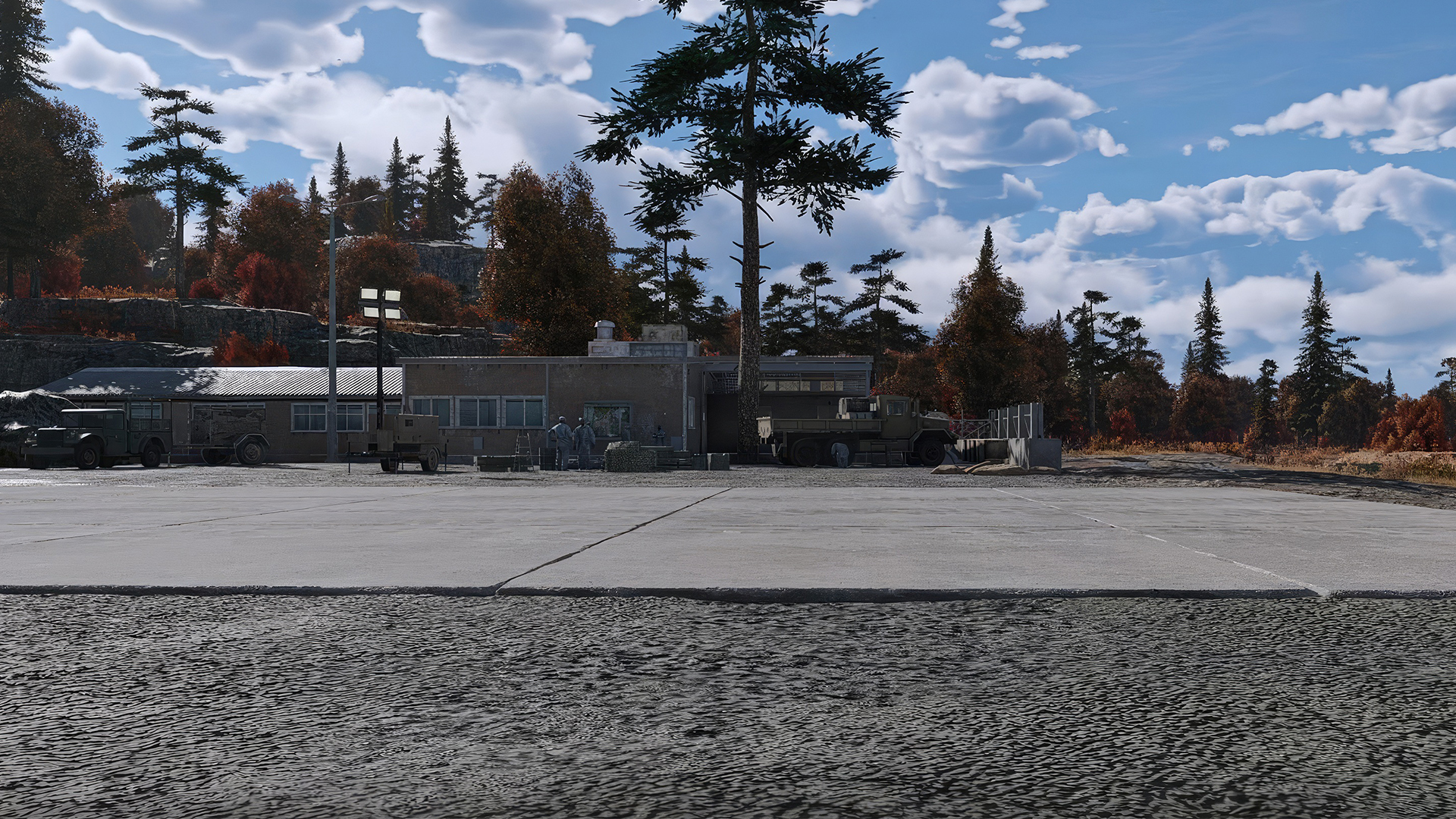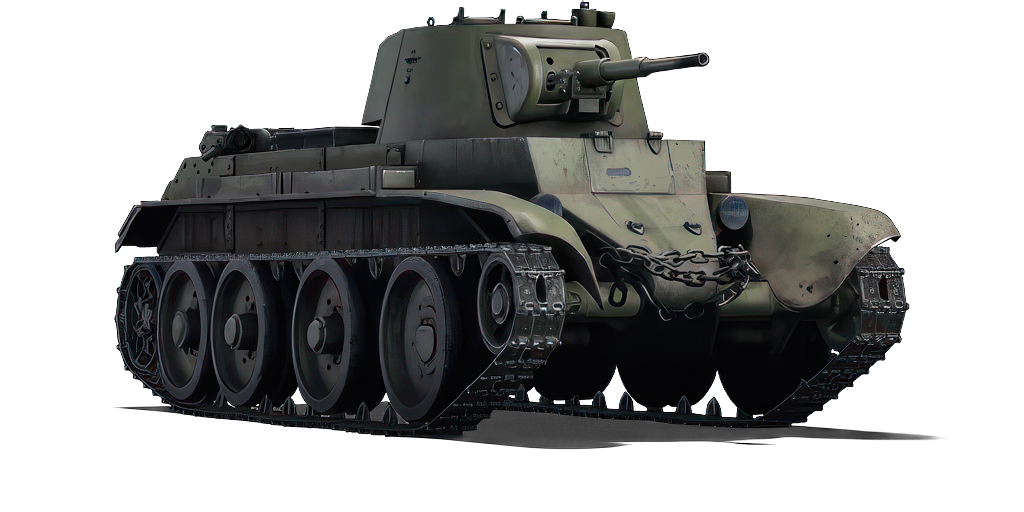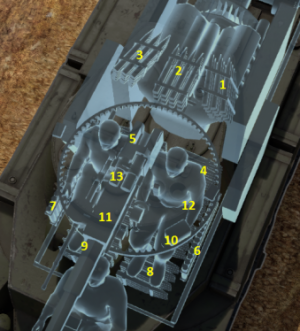BT-7
阅读
2024-02-19更新
最新编辑:瓦瑞克Warrick
阅读:
更新日期:2024-02-19
最新编辑:瓦瑞克Warrick
介绍
BT-7 1937 型发展自BT-5,是苏联陆军I级,权重1.3(街机/历史/全真)的一辆轻型坦克。BT-7和BT-5一样使用了45毫米20-K主炮和DT同轴机枪。与BT-5不同,BT-7的车体是焊接的,前部车体形状也进行了重新设计,采用了新的倾斜装甲炮塔。BT-7的前装甲从BT-5的13毫米加厚到了20毫米,改用了新的短螺距履带。不同于BT-5及更早的BT系列使用的M-5-400发动机,BT-7的动力来源是许可仿制自德国BMW VI V-12发动机的Mikulin M-17T发动机。BT-7参与了苏芬战争,在巴巴罗萨行动的早期也参与了对德军的抵抗,但在1941年后因战损而数量锐减。BT-7打完了整场二战。
BT-7是1935年至1940年间大量生产的苏联骑兵坦克BT系列的最后一型,也是BT-5的继任者。尽管BT-7是个脆皮车,但是对于同时期的载具而言BT-7的火力非常凶猛。BT坦克因首字母缩略词Betka而得名,或其昵称Betushka。
BT-7在苏联装备史中起了承上启下的效果,因为BT-7的继承者正是大名鼎鼎的T-34,后者于1940年面世,并将取代当时服役的所有苏联快速坦克、步兵坦克和中型坦克。
The BT-7 was introduced during the Closed Beta Test for Ground Forces before Update 1.41.
基本信息
生存能力和装甲
装甲 正面 / 侧面 / 背面
车体 20mm / 15mm / 13mm
炮塔 15mm / 15mm / 13mm
成员组 3 人
战场辨识度 83%
The armour is well angled at certain points like the front, however being as thin as it is, don't count on it to protect you very well. With 20mm armour on the front and with all that inclination on the armour panels, this vehicle had decent protection. With 5mm less armour on the turret, that's the vulnerability of the tank, especially on the turret's backside, where the ammo is stored. However, you only get 3 crew members in the vehicle, making the tank vulnerable to any "crew knocked out" scenarios. One strong point for the vehicle is that you have speed, and the trade-off of speed vs. armour can come in handy especially travelling around 59 km/h (It's very hard to reach 60 km/h) ensures any enemy SPG will be very unlikely to hit close to you.
装甲类型:
- Rolled homogeneous armour
| 装甲 | 正面装甲(倾斜角度) | 侧面装甲 | 后侧装甲 | 顶部装甲 |
|---|---|---|---|---|
| 车体 | 15mm ((8°)上部 20mm(18°)驾驶员舱门 20mm(5°-52°)下部 |
20mm 驾驶员舱 15 + 4mm 战斗舱和动力舱 |
10mm (55°) 上部 13mm (15°) 中部 13mm (58°) 下部 |
10mm 4mm 发动机散热口 |
| 炮塔 | 15mm (7-53°) 炮盾 15mm (13°) 炮塔前部 |
15mm (13°) 前部 13mm (13°) Bustle |
13mm (15°) | 10mm |
备注
- 履带、悬挂和负重轮厚15毫米
- 首下装甲只有6毫米
- 挡泥板和储物箱有4毫米厚
- 乘员和引擎之间有4毫米的挡板
机动性
速度 前进/倒退
街机 60/12km/h
历史与全真 54/11km/h
挡位 前进3挡
倒车1挡
重量 13.7吨
发动机马力
街机 763马力
历史与全真 400马力
功重比
街机 55.7hp/t
历史与全真 29.2hp/t
| 游戏模式 | 最大速度 (千米/时) |
重量 (吨) |
发动机马力 | 功重比 (马力/吨) | |||
|---|---|---|---|---|---|---|---|
| 前进 | 倒退 | 白板 | 完全体 | 白板 | 完全体 | ||
| 街机 | 60 | 12 | 13.7 | 620 | 763 | 45.26 | 55.69 |
| 历史与全真 | 54 | 11 | 354 | 400 | 25.84 | 29.2 | |
BT-7是一辆非常高速的脆皮小车。凭借速度优势,BT-7很适合绕侧打击敌方侧装甲。由于车体轻、速度快,BT-7过弯时会出现漂移的现象。为了更好控制,过弯前应该先收油门收油门!收!撞到啦!,并辅以轻点“A”或“D”进行转向。这需要时间去适应,但一旦适应就很容易上手T-34的急转。
速度是你最好的防御,所以保持高速并跑S型(39下高)来避免被远距离狙杀。(也别转得太猛,不然会掉速度)
BT-7的越野能力非常出众,而且越野条件下也没那么容易出现漂移。由于BT-7有M2轻型坦克 和 二号坦克所不具备的宽履带,所以它越野条件下的最高速度相比公路速度差不了多少.
Like its predecessor the BT-5, the BT-7 has competitive mobility, easily being able to reach capture points before most other tanks or get to competitive camping spots before anyone else, the 400 hp engine gives the BT-7 a good power-to-weight ratio, which also allows the BT-7 to scale hills and smaller obstacles with relative ease. 和前型BT-5一样,BT-7机动性出众,适合抢在其它坦克之前占点或者占据适合架炮的点位。此外,BT-7的400马力发动机带来了良好的功重比,这也使得BT-7能相对容易地爬上小山和小型障碍。
Modifications and economy
最高维修费 白板 → 完全体
街机 100 → 129
历史 96 → 123
全真 112 → 144
改装件总成本 2970
890
护身符 190
成员组培训费 200
专家 1000
王牌 20
王牌(研发点) 96000
战斗收益 街机 / 历史 / 全真
10% / 12% / 15%
100% / 100% / 100%
Armaments
主要武器
弹药 188 发
装填时间 普通成员组 → 王牌成员组
3.8 → 2.9 秒
垂直射界 -6°/25°
The 20-K is the typical Soviet rank I gun. Players should get used to it since it will be your main armament up until rank II. The APHEBC round has a good amount of HE filler, meaning penetrating shells will do good damage, sometimes even one-shotting enemies. At much longer ranges, shells begin to lose penetration and accuracy but on most common low tier maps this is not a problem due to the smaller map sizes.
| 45mm 20-K 反坦克炮 | 炮塔转速 (°/s) | 装填时间 (秒) | |||||||||||
|---|---|---|---|---|---|---|---|---|---|---|---|---|---|
| 模式 | 备弹数 | 垂直 | 水平 | 稳定器 | 白板 | 改装件 | 满级 | 专家 | 王牌 | 白板 | 满级 | 专家 | 王牌 |
| 街机 | 188 | -6°/+25° | ±180° | 无 | 15.23 | 21.08 | 25.60 | 28.31 | 30.12 | 3.77 | 3.33 | 3.07 | 2.90 |
| 历史与全真 | 9.52 | 11.20 | 13.6 | 15.04 | 16.00 | ||||||||
弹药
| 穿透统计 | |||||||
|---|---|---|---|---|---|---|---|
| 弹药 | 弹药类型 | 0°角时的穿透力 (mm) | |||||
| 10 m | 100 m | 500 m | 1,000 m | 1,500 m | 2,000 m | ||
| BR-240 | APHEBC | 70 | 68 | 59 | 50 | 42 | 35 |
| BR-240SP | AP | 73 | 71 | 62 | 52 | 44 | 37 |
| 炮弹细节 | |||||||||
|---|---|---|---|---|---|---|---|---|---|
| 弹药 | 弹药类型 | 出膛速度 (m/s) |
弹头质量 (kg) | 引信延迟 (m) |
引信灵敏度 (mm) |
TNT当量 (g) | 跳弹概率 | ||
| 0% | 50% | 100% | |||||||
| BR-240 | APHEBC | 760 | 1.43 | 1.2 | 9.0 | 29.3 | 48° | 63° | 71° |
| BR-240SP | AP | 757 | 1.43 | 0 | 0 | 0 | 47° | 60° | 65° |
弹药架
| 满弹药 | 1号 弹药架 |
2号 弹药架 |
3号 弹药架 |
4号 弹药架 |
5号 弹药架 |
6号 弹药架 |
7号 弹药架 |
|---|---|---|---|---|---|---|---|
| 188 | 174 (+14) | 162 (+26) | 147 (+41) | 135 (+53) | 123 (+65) | 108 (+80) | 89 (+99) |
| 8号 弹药架 |
9号 弹药架 |
10号 弹药架 |
11号 弹药架 |
12号 弹药架 |
13号 弹药架 |
视觉 差异 | |
| 73 (+115) | 57 (+131) | 41 (+147) | 25 (+163) | 13 (+175) | 1 (+187) | 否 |
备注:
- Racks disappear after you've fired all shells in the rack.
- Turret empty: 147 (+41) shells.
- Turret and side racks empty: 89 (+99) shells.
机枪
弹药 1890 发
待发弹药架 10 发
弹盒容量 63 发
装填时间 普通成员组 → 王牌成员组
10.4 → 8.0 秒
射速 600 发/分钟
Main article:'DT (7.62mm)
| 7.62mm DT 机枪 | ||||
|---|---|---|---|---|
| 位置 | 弹药容量 (弹盒容量) | 射速 | 垂直射界 | 水平射界 |
| 并列机枪 | 1,890 (63) | 600 | 无 | 无 |
Usage in battles
There are two common schools of thought when driving the BT-7, firstly rushing a capture point using your better than average mobility to get there before other friendly or enemy tanks. This tactic can help to gain points early in the game and perhaps even a few kills as enemy tanks try to take the point that you captured, but your fairly thin armour will leave you at risk of being crippled and destroyed by enemy fire unless you retreat to cover or get back up from friendly vehicles. The second school of thought is not to charge right into the combat, but wait a while to see how the battle develops - observe where and how many enemy tanks go, maybe fire a few shots from a distance. Use your great mobility to get to the best positions and flank the enemy, from these positions you could snipe into the main battler area to damage and kill enemy vehicles. You could then decide to use the BT-7's mobility to charge at lonely opponents, which at close range have no chance of keeping their guns pointed at you as you can essentially drive circles around them. Keep in mind that charging into more than 1 opponent is usually a quick end as it is very hard to not get hit by either of them at the same time. There is basically paper armour on BT-7 to stop anything other than machine-gun fire, overall speed is key, being mobile and changing your position often will be a great way to avoid enemy fire and potential revenge kill attempts.
If you lose one of your 3 crew members it would be advisable to head to a friendly capture point to use your crew replenishment as your vehicle needs 2 members to operate, and having a 'spare' crew member can come in handy.
Enemies worth noting:
- 二号坦克 C 型:Although not as fast as the BT-7, the Pz.IIs still have an average speed of around 40 km/h. Also, they are equipped with a deadly 20mm autocannon that will punch holes on the BT-7 with ease, and their rate of fire can quickly kill multiple crew. The BT-7 has thin armour protecting only 3 crew, making it extremely vulnerable to those autocannons. Try to finish them before they shoot at you.
- Sd.Kfz.234系列:These wheeled vehicles all have scary on-road speeds of more than 60 km/h, so in any map, with roads connecting to the points they can always get there first and set up an ambush. However, these vehicles are wheeled meaning they cannot turn in place, they are rather sluggish when trying to turn, and they have either slow turret traverse or no turret at all, so the player can use this to their advantage. Wiggle/circle around them to avoid their guns and force them to turn, then aim carefully and immobilise them. Note that the DT machine gun on the BT-7 only has 10mm penetration at most, making it almost impossible to go through their armour and kill any crew, so don't think of destroying these wheeled vehicles with the MG.
- M8 轻型装甲车,M3 轻型坦克:These vehicles can be equally fast, and the M8 can outrun the BT-7 if it's travelling on road, allowing them to get to the point before the BT-7 does. Therefore, if America is on the other side the player might want to change their tactics and not rush the point since low tier battles are always filled with fast tanks. The M8 has a roof-mounted .50 cal MG which easily tears the BT-7's armour apart and kills the crew inside. Also, most of them have a vertical stabiliser that works at low speed, so avoid firing on the move with them.
- B1 bis:A heavily armoured tank for its BR, but do not panic when you see it. Don't fire at a distance unless you are directly aiming at its side armour. The best option is to try and get as close to it as possible (point-blank range is ideal) and shoot straight at its side. However sometimes due to a variety of reasons the player might be unable to flank it and has to face it frontally. If that is the case, shoot the rather vertical driver's compartment and there's a great chance of penetration, killing the driver and the commander (which is also the gunner for the turret). Or, shoot between the two guns on the turret to kill the commander/gunner. Or, shoot at the near-vertical part of the curved gun mantlet of the big hull-mounted gun.
Pros and cons
优点:
- Deadly firepower at its BR: high penetration of up to 70mm, with the 29 g TNT it can frontally one-shot most tanks like Pz.II, Chi-Ha or M3 Stuart; its firepower is effective even in high tier battles if aiming at the right spot
- One of the fastest tanks in the game, great acceleration and overall mobility makes it a nice point-capper, flanker and climber- can outrun the commonly seen M3 Stuart on road
- 3-4 second reload time is quick enough to destroy opponents it cannot one-shot, like Pz.IV C and LVT(A) series
- Adequate reverse speed of -10 km/h allows it to quickly retreat from danger when there is no time to turn around
- Small and low profile allows it to easily hide behind cover or bushes
缺点:
- Poor survivability: non-existent armour on all sides plus the closely packed crew makes it vulnerable to autocannons (Pz.II, Flakpanzer I), heavy MG (M13 MGMC) and even solid shells
- Turret and hull traverse is rather slow, meaning it may not be able to keep track of fast targets- this is also a disadvantage in a close-quarters duel, as other light tanks like M3 Stuart can turn way faster
- Although fast, it is still slower than the Sd.Kfz.234 series on road.
- Gun depression of only -6 degrees (worse than previous BT-5) means it cannot effectively fight in hills
- Fuel tanks and ammo are scattered inside and are prone to detonation upon being hit
历史
发展
Poor survivability: non-existent armour on all sides plus the closely packed crew makes it vulnerable to autocannons (Pz.II, Flakpanzer I), heavy MG (M13 MGMC) and even solid shells Turret and hull traverse is rather slow, meaning it may not be able to keep track of fast targets- this is also a disadvantage in a close-quarters duel, as other light tanks like M3 Stuart can turn way faster Although fast, it is still slower than the Sd.Kfz.234 series on road. Gun depression of only -6 degrees (worse than previous BT-5) means it cannot effectively fight in hills Fuel tanks and ammo are scattered inside and are prone to detonation upon being hit
Combat usage
The BT-7 served alongside its older counterpart BT-5 tanks. The BT light tanks were meant to be cavalry tanks, and at the time of their introduction, they were considered some of the finest tanks against other countries' tanks. They had great mobility of all available tanks, and its 45mm gun could perform very well in combat. The only drawbacks of the design were its light armour and its gasoline engine, which caused the design to be rather flammable to improvised incendiary weapons. The BT-7's most notable combat service came against the Japanese at Khalkhin Gol. The tactics of Soviet Marshal Georgi Zhukov and the performance of his BT-5 and BT-7 tanks led to a decisive victory. It was during this battle that the BT tanks' tendency to catch fire was found, but its performance was positive against the inferior Japanese armoured forces.
The BT-7 next combat use was during the opening stages of Operation Barbarossa when Nazi Germany invades the Soviet Union. The superior German tanks Panzer III and Panzer IV was able to easily take out these lightly armoured tanks. Reports note that about 2,000 BT-7 tanks were lost in the first 12 months alone against the German forces, with hundreds broken down from low maintenance and were abandoned. Despite their inferiority, the Soviets continued to produce and field them among armour and mechanized units to boost their operational capacity, though most were kept away from the front lines due to their inadequacy. The BT-7 would finally see its service again in the Soviet invasion of Japanese-controlled Manchuria. The Soviets fielded the BT-7 and other tanks in its inventory against the inferior Japanese forces in Manchuria, where it proved very effective against the more lightly armoured Japanese tanks employed. The BT series were all retired after the end of World War II due to their obsolete design as an inter-war period tank design.
Legacy
Perhaps the most important impact of the BT light tanks series was that it kick-started the development of the T-34 medium tank, which would go on as the most-produced tank of World War II. A new design team was formed in 1937 at the KhPZ factory, where they built prototypes utilizing more armour and a heavier gun onto the design, which was called the A-32 and was approved for production as the T-34 tank. The BT tanks also serve as the basis of support vehicles such as the BT-7A artillery tan, BT-7TU command tank, OP-7 flamethrower tank, and even the TT-BT-7 remote-controlled tank. An attempt in 1940 also had the BT-7 up-armoured with hinged homogeneous armour, which added five tons to the design weight. These vehicles are not known to have seen service in combat units. The BT-7 also holds the record for the furthest jump in a tank, at 42 metres, set in 1936.
游戏内描述
In the second half of 1937, the BT-7 tank was mass-produced with a conical turret, a three-speed gearbox and strengthened suspension. In comparison to the BT-7 Mod. 1935, the tank's weaponry became more powerful due to the inclusion of a DT machine gun in the turret. Its ammunition capacity was increased by 44 and totalled 188 rounds in the battle vehicles and 145 rounds in the command vehicles equipped with a radio set. Some of the tanks were equipped with an anti-aircraft gun.
The unit command vehicles were equipped with a 71-TK-1 radio set with a hand-rail antenna, and later with a rod antenna. To allow the vehicle to fire its cannon and coaxial machine gun at night, it was equipped with two special projector headlights. Over the course of its modernisation, the thickness of its frontal hull armour reached 22mm. The turret's armour was also strengthened using vertically sloping armour plates. Its combat-loaded weight grew to 13,925 kg. Factory No. 183 alone manufactured 4,727 tanks of this series.
The BT-7 underwent its trial by fire in the Khalkhyn Gol river region as part of the 6th and 11th tank brigades. In the process, the latter undertook a hurried 500 km trek to the scene of the conflict. On the whole, the tanks gained a good reputation, but their drawbacks were noted as well: they were difficult to drive, which meant they required highly trained drivers, and they had insufficient armour and poor communication equipment. All these flaws were confirmed in the Poland Campaign of September 1939 and in the Winter War with Finland.
With appropriate tactics and a well-trained crew, the BT-7 could successfully oppose all types of German tanks at the beginning of the war, being inferior to them only in armour.
BT-7 tanks participated in combat operations on the Soviet-German front right up until 1944, and in 1945 they served in the war with Japan. A few captured tanks served in the Finnish army until the beginning of the 50s.
See also
Links to the articles on the War Thunder Wiki that you think will be useful for the reader, for example:
- reference to the series of the vehicles;
- links to approximate analogues of other nations and research trees.
External links
Paste links to sources and external resources, such as:
- topic on the official game forum;
- other literature.
| ||||||||||||||||||||||||||||||||||||||||||||||||||||||||||||||||||||||||||||||||||||||||||||||||||||||||||||||||||||||||||||||||||||||||||||||||||||||||||||||||||||||||||||||||||||||||||||||||||||||||||||||||||||





 沪公网安备 31011002002714 号
沪公网安备 31011002002714 号